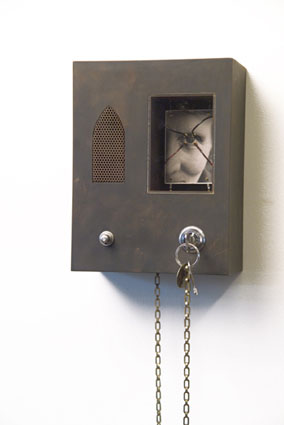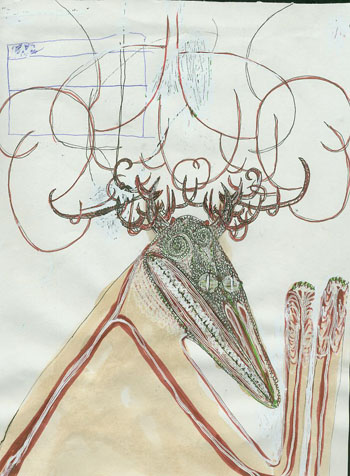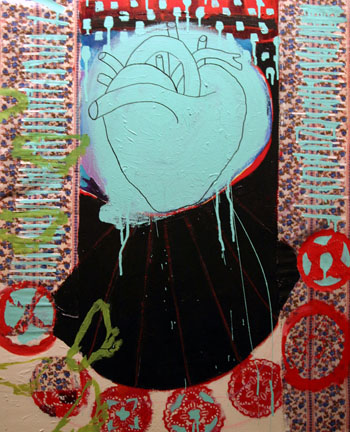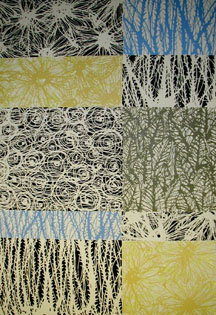Young and Restless: Full House
Suzanne Szucs writes on "The Young and the Restless," a show of artists under 30 from Duluth at the Duluth Art Institute. There's a lot to see--and it's up through August 7 at 506 W. Michigan Street in the Depot building.







Art making is alive and well and living in Duluth. A new generation is stepping up to the plate here and it is a pleasure to behold. Jeff Kalstrom, former exhibition coordinator for the Duluth Art Institute, has put together a show of young artists that showcases the raw talent haunting the streets of this town. If there is a failing in this show, it is that there is too much talent and so the show is congested with work that can’t properly breathe. But hey, if it can’t be perfect, then I’ll take the overabundance. With this much work, though, it’s impossible to comment on each artist, so I’ll concentrate on my “super” show – those contributors who I think bring the most realized or challenging work to the exhibit.
David Everett creates sculptural assemblages made primarily of found wood and iron scraps. They often feel too weighty when hung on a wall. But his Lunar Society, freestanding in the middle of the main gallery, is fabulous. Everett’s Luna has a use, albeit from another place and time – that’s what gives it power and mystery. Similarly, his Angels for the Times at their best feel like archeological finds: these rusted-out iron Ken dolls with wings might be religious icons from a lost society. Everett makes the mistake of exhibiting them with the plastic models, though, which go nowhere and spoil the illusion. Other work feels too autobiographical, with not enough for the viewer to hold onto. I appreciate the use of photography in his work, but often it seems too precious, ripped too precisely.
Andy Witrak’s sculptural wall pieces are much more refined and contextualized: boxes that feel like mechanical confessionals. With titles like Machine for Extracting Humility from the Soil, one can get caught up in his declarations; we can all relate. It’s impossible to not be moved by their poignancy and humor, but they are cramped into a corner space when they might be more effective spread throughout the gallery.
Ben Boylan’s tape creatures are magical, nonsensical. Their presentation in curio boxes gives them greater significance. Boylan twists masking tape into fantasy creatures that feel like representations from some scientific exploration. The medium looks like skin, yellowing up, drying out. Like a natural historian, Boylan accompanies this work with simple drawings of these new species.
Boylan is an artist to watch; he’s fearless. He is half of the duo (along with Cassandra Carlson-Vergona), responsible for the installation Unfinished Business presented in the DAI’s hallway that had been up since November of last year and frankly should have been purchased and made permanent. Covering the walls with Tyvek and painting them salmon pink, then adding flowers, fantastical paintings, a child’s bed, a sitting desk for writing letters Victorian style, this piece showcased their two big imaginations to perfection and was always a pleasure to pass through or linger in.
The most successful painters in the show embrace abstraction. Eric Dubnicka’s work creates illusion by emphasizing foreground/background relationships. His strange creatures seem to hover in front of the viewer like amoebae under a microscope. The images seem comic at first glance, but hold the viewer, especially in places where the paint has crusted up like an aging science experiment.
Pablo Pacheco’s work mesmerizes. Creating patterns from nature, he lays them down in geometrical areas that compete with one another. His strongest pieces break away from the rectangle, allowing irregular shapes with varying patterns and color schemes to intrude upon one another. The visual confusion this causes creates a depth that the imagery and technique itself lacks.
Bridging sculpture and painting is the work of Cassandra Carlson-Vergona. She commands her own small gallery alcove off the main room, and treats this space like a mini-solo show, greeting viewers with the fabulous Him and Her at the entrance: two absurdist child mannequins with mouths hanging open in semi-sexual glee. Carlson fills out her space with feminist-driven work that explores the gender relations of her mother’s generation. For this show she has created collages of traced wedding pictures sandwiched with doilies and fabric. The handwritten text reminds the new bride to sublimate her own feelings and ideas to her husband, but it is the titles that wound. They are offered like short clips from a filing reference drawer: “Offers May Come Later,” “Back an Old Lover,” “A Certain Amount of Makeup…” In Carlson’s work there is a joy in materials, and risk-taking that leads to pure visual pleasure.
Another painter of note who rounds out my fantasy show is Sarah Heimer. Her best pieces, Ghost Rider and LaGuia, are nearly monochromatic; she has stripped away the top layer of paint, revealing the texture of the canvas and the shapes of her dream world. In these two pieces she controls the compositions while still letting them breathe. I admire her attempt to at times allow her dream thoughts to erupt onto the panel, taking a cue from Asian landscapes.
There is a lot more talent on display in this exhibition as well as some notable exceptions; and the choices are unfortunately limited to sculpture and painting. Regardless of these failings, the show for the most part is a revelation and at the very least, fun. It is good to see so much promise in the northland – so much energy and enthusiasm. It speaks well of local artists like Adu Gindy and Bill Shipley who have dedicated so much support to up and coming artists, and to Jeff Kalstrom who by all reckonings can always be found rubbing shoulders with the young and the restless.